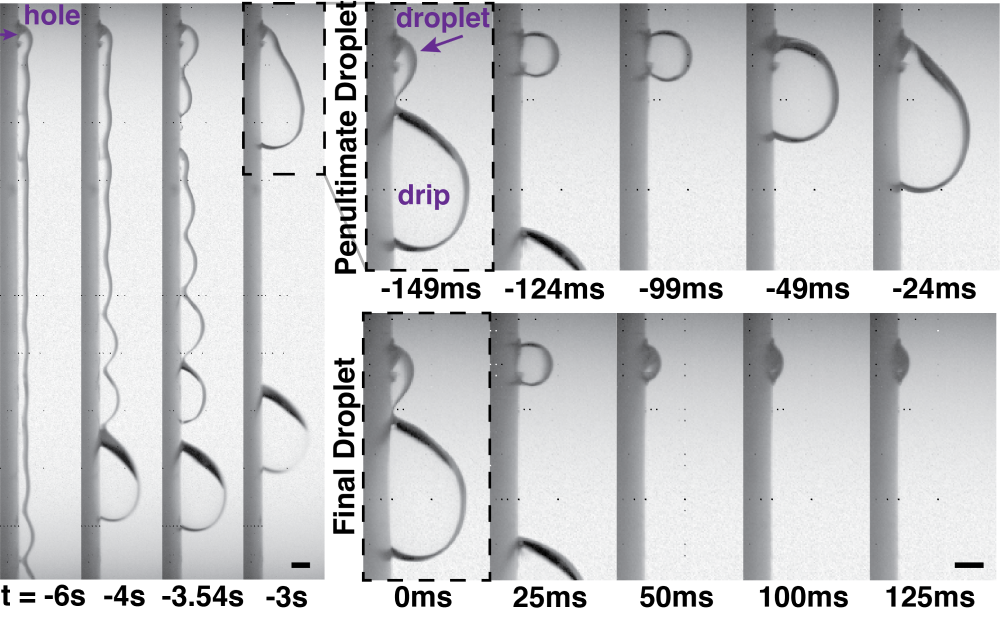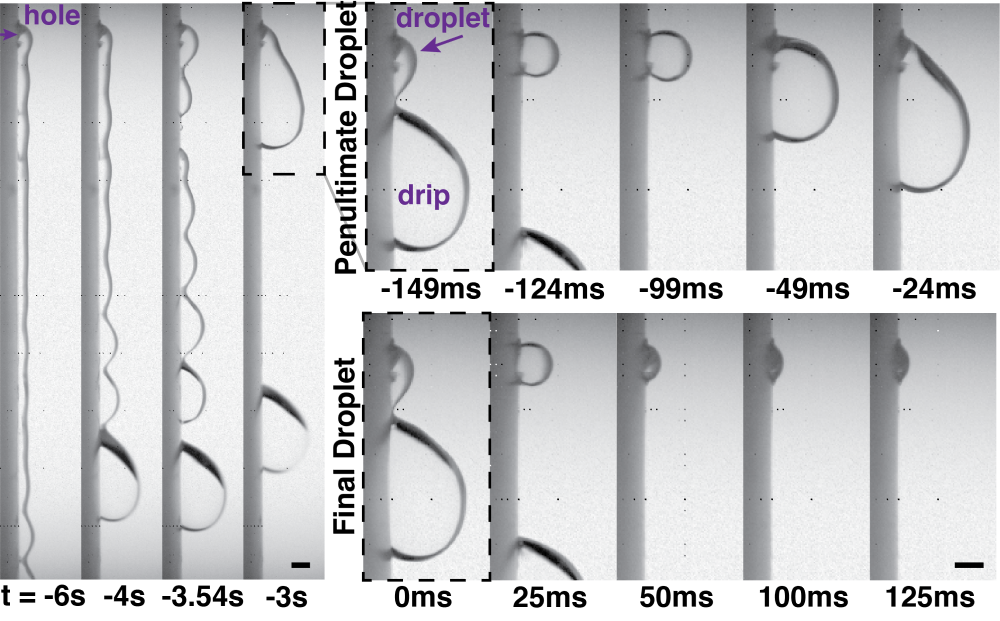How a Leak Can Stop Itself
A leaking pipe can mean many things. It could mean an expensive visit from the plumber, a satisfying DIY repair project, or the start of a counterintuitive physics puzzle. Recent experiments discovered that a leak from a small hole in a vertical pipe can sometimes stop spontaneously. Katharine Jensen of Williams College in Massachusetts and her colleagues now explain this unexpected behavior by studying the energy of the “capping” droplet that seals the leak [1]. Their classical mechanics analysis could lead to novel pipe designs and ways to create valve-like action without moving parts. The work was presented at the Spring meeting of the American Chemical Society in March.
When a vertical, liquid-filled pipe springs a leak, several things might happen. If the pressure is high enough, liquid will spray out of the hole in a jet. Or, for lower driving pressures, the liquid might roll down the pipe’s exterior—like tea dribbling from the spout of a teapot. Recent experiments by engineers working in industry show that the leak might also simply stop, sealed by a small capping droplet. That’s surprising because the leak stops even when there’s still a nonzero pressure trying to push the fluid out. “It’s straightforward how a leak starts,” says Jensen. “But how and why does a droplet stop the leak?”
These questions prompted her to use a high-speed video microscope to capture the complete process of both forming and stabilizing a capping droplet. She and her colleagues created a simple experiment involving a 15-mm-diameter cylindrical pipe filled with 15 mL of water. They drilled a 0.8-mm-diameter round hole in the pipe’s side near its bottom and observed the water’s behavior as it drained out. The pressure at the leak site slowly dropped as the level of water in the pipe fell.
From their 1000-frames-per-second video, the researchers observed that before a leak would stop, it had to undergo a transition from a continuous flow—either a jet or a dribble—to a slower “drip, drip” behavior. In the latter case, after each drip the hole was covered by a droplet that grew in size and eventually broke off and rolled down the side of the pipe, leaving behind a new droplet. The process repeated roughly 15 times until one of the droplets stopped the leak. “This final one stabilized and appeared to wobble in a way that held it in place,” Jensen says.
To explain their findings, the researchers calculated the potential energy of the final capping droplet as a function of its volume, taking into account the fluid surface tension, driving pressure, and contact area. They calculated the critical pressure, which corresponded to the maximum driving pressure that a capping droplet can withstand. Above that pressure, the droplet grows and the pipe continues to leak. At the critical pressure, the leaking was predicted to stop, as the potential energy landscape has a dip, or “well,” that can trap the system in a stable, nongrowing droplet state. However, the observations showed that the dripping continued and only stopped when the pressure fell below the critical point. “We realized there was something missing,” Jensen says.
Clued in by the wobbling that appeared in the images, Jensen realized that the missing element was kinetic energy. “To calculate kinetic energy, you need to know something about the mass,” she explains. By measuring the oscillations and calculating the shape of the potential well near its minimum, she could treat a capping droplet like a classical mass-and-spring oscillator, determine its effective mass, and from there determine the total energy—potential plus kinetic—that a droplet has when it is created. The total energy, in turn, determines whether or not a droplet becomes trapped in the well—and therefore whether the droplet is likely to stop the leak. “Using a classical mechanics approach to solve a fluid dynamics problem is an unusual thing to do, and the mass-and-spring is as classical as it gets,” says Jensen.
Chuck Extrand, a chemical engineer and the director at AceMarga, a polymer material consultancy, points out that previous work, including his own, was only partially able to explain and model the unexpected self-arrest of a pipe leak. And while physicists have studied dripping and jetting, the onset of leakage—and its eventual cessation—has received almost no consideration in the past. By diving into this uncharted scientific area, researchers may be able to address a problem that is of industrial importance, as leaking fluids can damage electronics, the environment, and pharmaceutical production lines, Extrand says.
Besides helping to mitigate leak damage, Jensen says that understanding capping droplet behavior could lead to methods for dispensing small, controlled amounts of fluid without needing a mechanical valve or other moving parts. However, such future applications will likely depend on the pipe surface and the liquid itself: leak stopping is not a guarantee. “If scientific studies are ultimately to inform the design of new types of fluid handling and valving mechanisms, it will be important to understand the limits of this phenomenon,” Extrand says.
–Rachel Berkowitz
Rachel Berkowitz is a Corresponding Editor for Physics Magazine based in Vancouver, Canada.
References
- C. D. Tally et al., “How a leak can stop itself,” arXiv:2202.02644v1.





